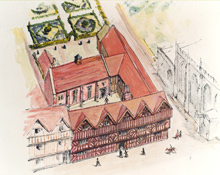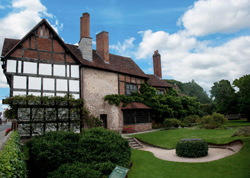An archaeological dig at one of Shakespeare’s houses hopes to reveal new facts about the world-famous playwright’s later life.
 |
WILLIAM SHAKESPEARE’S later life is being further explored through a new archaeological dig that has just started at New Place, the house that the playwright owned for 19 years and where he was living at the time of his death in 1616. The ‘Dig for Shakespeare’ is being organised by Birmingham Archaeology, with a team of volunteers, and they will be excavating three locations within the grounds of New Place.
The public is invited to watch as the story unfolds: a scaffolding walkway and viewing platform has been installed and you will be invited to question the archaeologists while they work. You can also keep up to date with the dig through a new website, www.digforshakespeare.com, which has been created by the Shakespeare Birthplace Trust to keep potential visitors, as well as Shakespeare fans throughout the world, up to date with the latest news from the site. â¨â¨
Shakespeare’s house at New Place was built on three sides of an open courtyard on the corner of Chapel Street and Chapel Lane. The largest trench will run from the servants’ quarters in the Chapel Street wing – where the foundations of the later 1702 building will be uncovered – across the courtyard to the rear wing, which is where Shakespeare and his family would have worked and lived. â¨â¨A second trench will explore the area thought to have been his pantry and brewery, and a third one will dig up a quarter of the 19th-century knot garden – into what would have been Shakespeare’s backyards. This is where archaeologists believe they might find defunct wells, filled in with refuse and waste when they ceased to be used. â¨â¨Wells hold all kinds of secrets as the anaerobic conditions preserving organic waste and detritus, so this may give the Trust a real insight into the lives of the occupants.
 |
“Six test pits excavated last October gave us confidence that this will be a productive dig,” adds Dr Diana Owen, Director of the Trust. “Who knows, we might find one of Shakespeare’s shoes, some of his discarded correspondence or even some of his personal effects – only time will tell!”
Image of Nash Place today (above) by Justine Harrison Wood Photography.






 © 2024
© 2024